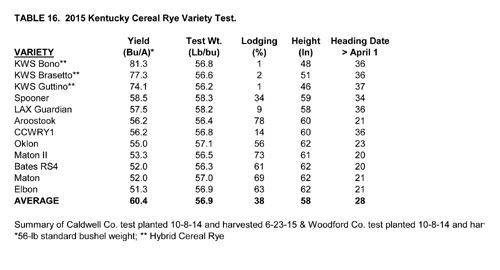Variety Selection And Cereal Rye Production
BILL BRUENING
LEXINGTON, KY.
Cereal rye is often planted in Kentucky as a cover crop. Cover crops can reduce soil erosion, suppress weeds, scavenge residual nitrogen and add organic matter to improve soils. Of the winter small grain crops grown in Kentucky, cereal rye is reported to be the most cold tolerant and has the quickest vegetative growth rate. It is primarily grown for grain production in Europe and to a lesser extent in North America. In the U.S., 258,000 acres were planted in 2014 and grain yields averaged 30 bushels per acre. Most U.S. grain is produced in South Dakota, Georgia, Nebraska, North Dakota and Minnesota. Cereal rye grain is used for food, to make alcoholic beverages, and for livestock feed. Cereal rye is also used for pasture, and for forage/silage production and is typically cut for hay/silage at heading. The standard grain test weight for rye is 56 lbs/bu compared with 60 lbs/bu for wheat. The plants are tall (4-6 ft), susceptible to lodging (depending on variety & fertility) and produce substantially higher straw yields than other small grain crops.
In Kentucky, cereal rye should be planted between October 10 – October 31 at a rate of 60-90 lbs/acre for grain and 90-120 lbs for forage production. Fungicide seed treatments are an inexpensive and effective method of protecting seeds and seedlings from disease. Insecticide seed treatments will also provide some protection from fall insects, such as aphids which can be an issue with early fall planting in warmer conditions. Management of cereal rye is similar to wheat with the exception of spring N fertilization, where a single application of 60 lbs N is recommended in early March. Excessive N rates can cause lodging and disease issues. Hybrid rye varieties may be able to resist lodging and increase yield potential at higher N fertility levels, but that response is not known and is currently being investigated at UK. Depending on the variety, rye grain can reach harvest maturity a week before or after wheat.
Kentucky Small Grain Variety Performance Test Results are available at http://www.uky.edu/Ag/wheatvarietytest/. The UK program evaluated winter cereal rye varieties for differences in grain yield potential, as well as test weight, heading date, plant height, winter hardiness, and lodging.
In the 2015 Kentucky Cereal Rye Trial (Table 16), common and hybrid rye varieties were evaluated using standard management practices with 70 lbs nitrogen applied at Feekes 4-5. Common varieties on average yielded less (55 vs. 78 bu/a), were taller (61 vs. 48 inches), and had dramatically higher levels of lodging (51 vs. 1%), when compared with hybrids. Among common cereal rye varieties, lodging ranged from 9 – 78 percent highlighting the importance of other genotypic characteristics besides yield in variety selection. ∆
BILL BRUENING: Research Specialist, University of Kentucky
